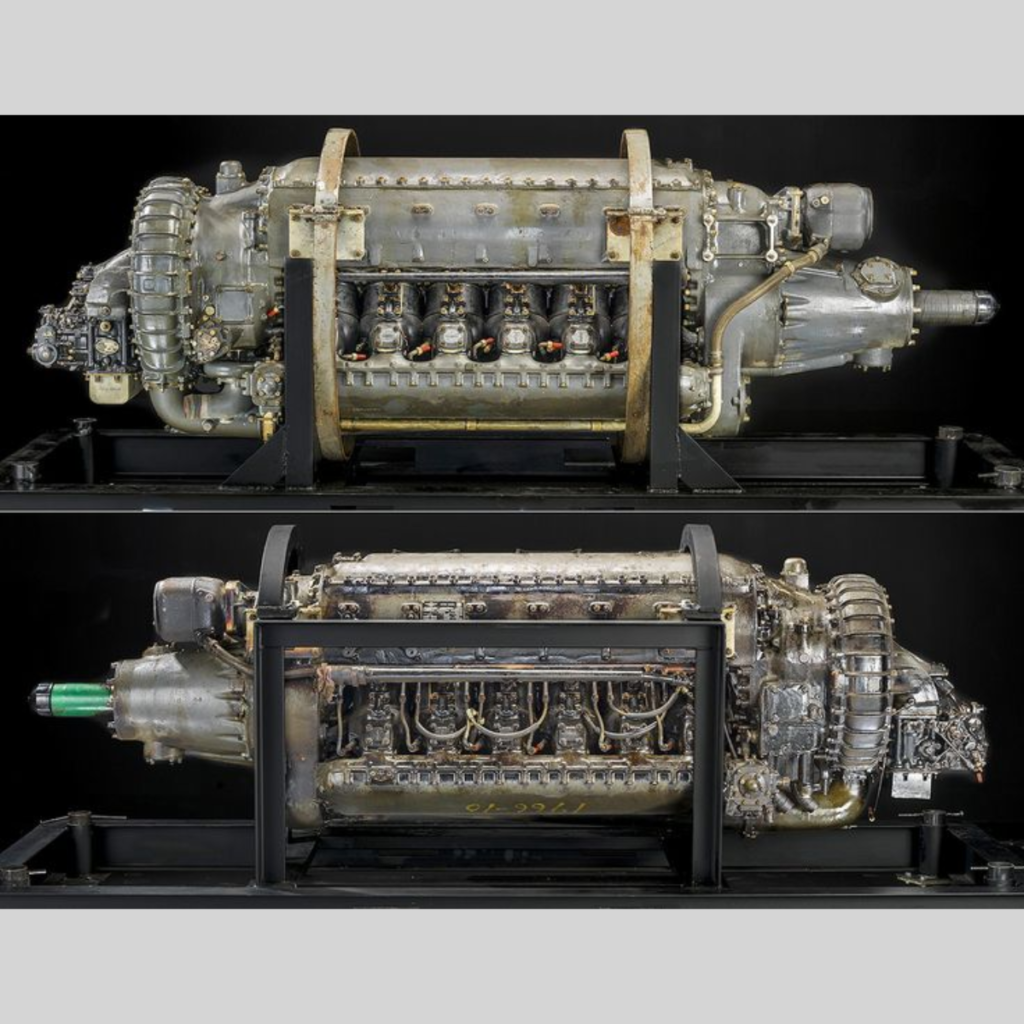
In the late 1920s, British engine expert Harry R. Ricardo hypothesized that the spark-ignition internal combustion engine with poppet valves had reached its specific power-producing zenith. The foundation for this belief was rooted in the fuel quality and technology employed at the time. Ricardo recommended that a single sleeve valve should replace the cylinder’s poppet valves and would enable the continued increase of an engine’s specific power output.

Sectional drawing of the Continental Hyper No. 2 cylinder from August 1933. The domed exhaust valve is on the left. The domed piston had recesses to provide clearance for the valves.
British expatriate turned American citizen Sam D. Heron was also an engine expert and was employed at the time by the Army Air Corps (AAC) at Wright Field in Dayton, Ohio. Heron was involved in engine research, and with the approval of the AAC, he began to explore the power limits of the spark-ignition internal combustion cylinder with poppet valves. However, Heron had access to one thing that Ricardo did not consider: sodium-cooled exhaust valves.
Around 1923, Heron had developed an air-cooled cylinder for use on the Liberty V-12 engine. This cylinder had a 4.625 in (117 mm) bore, a 7.0 in (178 mm) stroke, and displaced 117.6 cu in (1.93 L). Around 1925, Heron developed the sodium-cooled exhaust valve. These valves had a hollow stem that was partially (approximately 2/3) filled with sodium. Once the valve reached 208° F (98° C), the sodium melted. The up-and-down movement of the valve sloshed the sodium in the valve. The sodium absorbed heat from the valve head, cooling it, and transferred the heat to the valve stem. The valve stem extended out of the cylinder and transferred the heat to the valve guide boss and subsequently to the cooling fins (if air cooled) or the water jacket (if water-cooled). The exhaust valve was a hot spot inside the cylinder that could cause detonation. Detonation is the spontaneous combustion of the remaining air and fuel mixture inside the cylinder prior to the flame front propagating from the spark plug, after it has fired, reaches that part of the cylinder. The sodium-cooled valve reduced the valve’s temperature, helping to prevent the possibility of detonation, and enabled the cylinder to produce more power.
Around 1930, Heron took the air-cooled Liberty cylinder with a sodium-cooled exhaust valve and converted it to water-cooling by adding a water jacket around the cylinder barrel. The cylinder was used on a single-cylinder test engine and quickly produced more power than the poppet valve limits described by Ricardo. At the time, an average aircraft engine cylinder produced a mean effective pressure (mep) of around 150 psi (10.3 bar). Using a single sleeve valve engine, Ricardo was able to achieve an mep of 450 psi (31.0 bar). Heron’s test cylinder was able to achieve an mep of 360 psi (24.8 bar) on its first run. Heron’s test cylinder was reworked, and an mep of 500 psi (34.5 bar) was ultimately recorded.

Two views of the same Hyper No. 2 cylinder after its 49-hour test run in August 1933. The exhaust port is on the same side as the coolant pipe.
Encouraged by Heron’s test results, the AAC sought to develop a high-performance (Hyper) cylinder to be used on an aircraft engine. The cylinder kept the 4.625 in (117 mm) bore, but the stroke was reduced to 5.0 in (127 mm) to permit an engine speed of up to 3,400 rpm. With the change, the cylinder displaced 84.0 cu in (1.38 L). A proposed V-12 engine would incorporate 12 Hyper cylinders for a total displacement of 1,008 cu in (16.5 L) and a goal of producing 1,000 hp (746 kW). The AAC also desired a pressurized cooling system that ran straight ethylene glycol at 300° F (149° C). The then-current practice was to use normal water as the coolant, which limited the temperature to around 180° F (82° C). The high temperature was selected in an effort to decrease the size of the radiator needed in the aircraft. For proper cooling of a complete engine with the desired 300° F (149° C) coolant temperature, the AAC believed that individual cylinder construction would be required rather than six-cylinders together in a monobloc. However, an engine constructed with individual cylinders is less rigid than using monobloc construction, making the crankcase and cylinders prone to cracking when the engine is highly stressed. Individual cylinder construction also makes the engine heavier and longer, which increases torsional stresses on the crankshaft.
On 5 October 1932, a contract to develop the Hyper cylinder and design a complete 12-cylinder engine was issued to the Continental Motors Company. At the time, Continental built engines for a number of different automotive manufacturers and built medium-size air-cooled radial engines under their own name. Continental had also been contracted for experimental work on single sleeve valve engines by both the AAC and the US Navy.
Continental set up an office in Dayton, Ohio to work with Heron and the AAC regarding the design of the first test cylinder, Hyper No. 1. Continental built Hyper No. 1 to the AAC’s specifications at their main facility in Detroit, Michigan. Hyper No. 1 was constructed of a forged steel cylinder barrel screwed and shrunk into a cast aluminum head. A separate steel water-jacket was shrunk over the barrel and a shoulder of the head. The cylinder had a hemispherical combustion chamber with a single intake and a single sodium-cooled exhaust valve. The valves were actuated by an overhead camshaft via rockers. The rockers had a roller that rode on the camshaft and a pad that contacted the valve stem. Hyper No. 1 was first tested in early 1933 and soon produced 84 hp (63 kW) at 3,000 rpm, achieving the goal of producing 1 hp per cu in (.7 kW per 16 cc). However, there was some concern that a 1,008 cu in (16.5 L) engine producing 1,000 hp (746 kW) would be highly stressed, resulting in decreased reliability.

A drawing of the O-1430 included in U.S. patent 2,016,693 from October 1933 shows the engine’s basic layout. The cylinder appears to be nearly identical to that of Hyper No. 2, and the engine’s configuration matches what was ultimately built in 1938.
The AAC allowed Continental to develop a larger cylinder bore, resulting in Hyper No. 2. Hyper No. 2 had the bore increased by .875 in (22 mm) to 5.5 in (140 mm). This change increased the cylinder’s displacement by 34.8 cu in (.57 L) to 118.8 cu in (1.95 L). An engine with 12 Hyper No. 2 cylinders would displace 1,425 cu in (23.4 L), an increase of 417 cu in (6.8 L) over using Hyper No. 1 cylinders. Other AAC requirements, such as 300° F (149° C) coolant, individual cylinders, and a 1,000 hp (746 kW) output remained unchanged.
An endurance test report of Hyper No. 2 dated 3 August 1933 states that two cylinders were used for the test. The first cylinder failed due to cracks after 11 hours at 3,000 rpm and 9.8 psi (.68 bar) of boost. The second cylinder was run for 49 hours and produced 83 hp (62 kW) at 3,000 rpm with 6.9 psi (.48 bar) of boost. This gave an indicated mep of 211 psi (14.5 bar) and would enable a 12-cylinder engine to produce 1,000 hp (746 kW). However, the second cylinder also exhibited cracks at the end of the run, and numerous parts of both cylinders failed during or were worn out after the test. The report also states that the cylinder had a compression ratio of 5.9 to 1 and that the intake and exhaust valves were both sodium-cooled, but it is not clear if this was also the case with Hyper No. 1. The report includes a drawing of a piston listed as having a 5.75 to 1 compression ratio.
As testing of Hyper No. 2 was underway, serious discussions commenced regarding the design of a 12-cylinder engine. The AAC now wanted a flat (horizontally opposed cylinder) engine that could be installed in an aircraft’s wing and tasked Continental to build such an engine. The result was the O-1430, which utilized Hyper No. 2 cylinders. Sometimes the engine is referred to as OL-1430, for Opposed Liquid-cooled. It was assumed that a complete O-1430 engine would be built quickly and that the engine could be rapidly placed into service, with only a few years elapsing from design to production.

Wooden mockup of the Continental O-1430 engine. The model was very detailed and closely matched the actual engine. The model survived and is in a private collection. Note the intake manifold and its individual runners atop the engine.
The Continental O-1430 was a horizontally opposed (flat-12 or 180° V-12) aircraft engine. The two-piece aluminum crankcase was split vertically at its center. Six individual steel cylinders were attached via studs to each side of the crankcase. As installed on the engine, the air and fuel mixture entered the cylinder via a port on the top side, and the exhaust gases were expelled via a port on the bottom side of the cylinder. A camshaft housing was attached atop all of the cylinders on each side of the engine. The single overhead camshaft for each cylinder bank was driven from the front of the engine via a shaft and bevel gears. A magneto was mounted to the rear of each camshaft. One magneto fired one spark plug in each cylinder, and the other magneto fired the other spark plug. The spark plugs were both positioned on the intake side of the cylinder and flanked the intake port. The pistons were connected to the crankshaft via fork-and-blade connecting rods.
At the front of the engine was an accessory drive and propeller gear reduction. A double set of spur gears enabled the reduction and kept the propeller shaft on the same axis as the crankshaft. A gear reduction of .455 or .556 could be fitted without any modification to the reduction housings. Additionally, the accessory drive was designed so that swapping two gears would reverse the rotation of the accessory drive shaft relative to the crankshaft. In other words, the setup enabled the accessories to be driven in the same direction whether the crankshaft rotated clockwise or counterclockwise. There was no need for special accessories or gearsets when the engine was installed in handed operation. Reversing the relative positions of the starter and generator mounted to the sides of the front accessory drive and flipping their common drive shaft enabled those units to operate regardless of the clockwise or counterclockwise rotation of the crankshaft.

Top view of the complete O-1430 engine shows the accessory section at the front of the engine with the starter and generator. Note the camshaft drives and the leads from the magnetos to the spark plugs.
A downdraft carburetor was positioned at the extreme rear of the O-1430 engine. It fed air and fuel into the single-speed, single-stage supercharger, which was mounted to the rear of the engine. The supercharger impeller was 10.5 in (267 mm) in diameter and turned at 6.45 times crankshaft speed. An intake manifold led from the supercharger and sat atop the engine. Individual runners branched off the manifold and supplied the air and fuel mixture to each cylinder. A water pump with two outlets, one for each cylinder bank, was driven from the bottom of the supercharger drive housing.
The O-1430 had a 5.5 in (140 mm) bore and a 5.0 in (127 mm) stroke. The engine displaced 1,425 cu in (23.4 L) and had compression ratio of 6.1 to 1. Takeoff power was 1,150 hp (858 kW) at 3,150 rpm, and continuous power was 1,000 hp (746 kW) at 3,000 rpm up to 25,000 ft (7,620 m). The O-1430 was 104.5 in (2.65 m) long, 44.3 in (1.13 m) wide, and 24.2 in (.61 m) tall. The engine weighed 1,300 lb (590 kg).
Construction of the O-1430 was delayed by the development of the Hyper No. 2 cylinder. Almost all of the time from 1932 to 1938 was spent on refining the cylinder’s design. The AAC wanted the cylinder to be fully developed before the complete engine was built, and it took Continental years to fully satisfy the AAC’s requirements. Cracks in the cylinder were a constant issue as Hyper No. 2 was developed. Additionally, Continental seemingly did not want to spend any of its own money on the cylinder or engine, even though the company would eventually be reimbursed by the AAC. Rather, Continental sent each change and every purchase through the AAC for contractual approval. While this funding bottleneck severely slowed work, Continental was struggling financially in the Depression era. In addition, Continental believed that the engine would not be suitable for commercial use and that it would only power fighter aircraft. They felt that a fighter engine would not offer a significant return on any money that they invested into the project. At the same time, the AAC had very limited funds available for the experimental engine project.

Although the O-1430 achieved its desired output of 1,000 hp (746 kW), its protracted development rendered the engine obsolete. Had it been completed in 1935, the O-1430 may have found an application and been put into production.
The O-1430 was finally completed and run in 1938. This was about two years past the AAC’s originally envisioned timeline for the engine to be in production and powering various aircraft. The engine passed a 50-hour development test at 1,000 hp (746 kW) in April 1939. By this time, the concept of installing a flat engine in the wing of a fighter had fallen out of favor, as a fighter’s wings were too thin to house such an engine. In addition, a 1,000 hp (746 kW) engine was not powerful enough for fighters under development. The Allison V-1710 and the Rolls-Royce Merlin had both passed more stringent tests and produced more power years prior. In addition, Allison had convinced the AAC that 250° F (121° C) coolant was just as, if not more, efficient as 300° F (149° C) coolant. At 300° F (149° C), a lot of heat is transferred into the oil, necessitating a larger oil cooler. A larger radiator is needed at 250° F (121° C), but the oil cooler can be smaller, resulting in the same overall drag of the comparative cooling systems. Furthermore, the engine and all surrounding components and accessories lasted longer at the lower temperature. It was also found that pure ethylene glycol did not transfer heat as well as a 50/50 mixture of water and ethylene glycol.
A redesign of the O-1430 was offered in which the engine would be altered into a compact Vee configuration. With recent advancements, such as increased supercharging and better fuels, it was believed that the redesigned engine could be made to produce 1,600 hp (1,193 kW) and would be well suited for fighter aircraft. The engine was subsequently redesigned as an inverted V-12. It was officially designated as the Continental XIV-1430 and later became the XI-1430. Work on the O-1430 was halted.
On 11 September 1939, the AAC issued Request for Data R40-A seeking an 1,800–2,400 hp (1,342–1790 kW) engine for installation in a bomber’s thick wing. Continental proposed doubling the O-1430 to create the 24-cylinder XH-2860. This was the same thing Lycoming had done with its O-1230 when creating the XH-2470. However, the Continental XH-2860 did not find favor with the AAC, and the engine never proceeded beyond the preliminary design phase. The decision against the XH-2860 was based in part to allow Continental to focus on developing the XI-1430.

The XI-1430 was the final development of the O-1430 and Hyper cylinder program. Although the engine exhibited impressive performance, achieving 2,100 hp (1,566 kW) in August 1944, it had reliability issues and came too late to have any impact in World War II.



